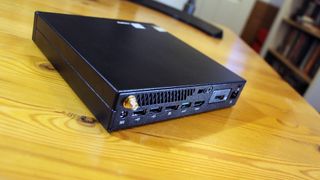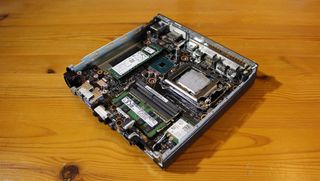IT Pro Verdict
The PB60 is an impressively well-made system that packs loads of features into its tiny frame – ideal for scenarios where space is limited. The low-power CPU has decent speed, too. Just remember that you’ll get more speed and upgrade room elsewhere if you don’t have to buy such a tiny system.
Pros
- +
Versatile, tiny design; Loads of connectivity; Decent low-power processor; Cool and quiet
Cons
- -
Full-power CPUs are faster; Few upgrade paths; No discrete GPU






The Asus PB60 is a convincing argument for the merits of tiny PCs in 2019. This latest system is one of the smallest we've ever reviewed - but it still contains a latest-generation Intel CPU, 16GB of memory and a 256GB SSD.
It's a lot of computing hardware inside a small package, and it only costs 694 exc VAT - which makes it cheaper than other small PCs we've seen recently.
Asus PB60 review: Design
The PB60 is truly, exceptionally tiny. It's only 34mm wide, and its sides are 175mm square. That makes it barely bigger than a paperback book. It only weighs 1.19kg, too, so it's several times lighter than your average office system.
The last small systems we saw offer comparable dimensions. The HP Elite Slice is just as tiny as this machine, while the Asus VivoMini is a tad larger and heavier. It's also worth noting that neither of those PCs had connectivity that's quite as good as the PB60.
When it comes to size, then, the Asus is impressive. And the PB60's tiny dimensions give this machine several advantages. It's small enough to use the included VESA 100 mount to attach to the back of a monitor, for instance, and it can slip into all sorts of spaces - from cramped desks to POS units. Asus also includes a vertical stand.
Asus PB60 review: Ports and features
There's no shortage of connectivity despite the PB60's size. At the front you've got pairs of USB 3.1 Gen 1 and Gen 2 ports - with Gen 2 allowing for a 10Gbit/sec data rate, which is twice as much as Gen 1. There's also a USB 3.1 Type-C connector, and two audio jacks.

The rear serves up a sole USB 3.1 Gen 2 port, two older USB 2 connectors, a Kensington Lock slot and a Gigabit Ethernet output. There are also HDMI and DisplayPort outputs and a wireless aerial connector. Cleverly, an extra port can be swapped for a different type of connector. On our review sample it's a DisplayPort output, but it could be swapped for HDMI, D-SUB or Serial ports.
The Asus VivoMini has a card reader, but fewer display outputs and USB connections. The HP Elite Slice suffers similarly, so neither are quite as versatile.
The PB60's exterior is made from sturdy metal. Build quality is great, with no give in any panels, but the PB60 is not an exciting machine to look at.
More intriguing is the internal access. One side can be removed with a single screw, and once you're in it's easy to take the PC to pieces. There's a spare 2.5in bay, and lifting that free grants access to the NVMe storage slot and that swappable output port. The heatsink and fan can be easily removed, and beneath that is the wireless chip, memory slots and standard desktop CPU socket.
It's an unfussy and simple system to work with, and it's easier to tinker with than the HP Elite Slice or the Asus VivoMini - both machines that are more consumer-friendly but with less internal access. Still, that's not going to be a big concern if you need a small PC for a specific environment - and especially if you won't be diving inside all that often.

There's more coming, too: Asus says that different expansion modules will be built for this PC, and that they'll be able to stack vertically. The first will add an optical drive, and more are apparently planned. It's a similar system to the HP Elite Slice, which already has modules to add an optical drive and better audio.
Asus PB60 review: Hardware & Performance
The PB60 has an Intel Core i7 processor that uses the firm's latest Coffee Lake architecture - which means a refined 14nm production process, more efficient transistors and better speed control within the chip - all upgrades that bode well for cool, efficient operation.
The chip of choice is a Core i7-8700T. It has six cores with Hyper-Threading, which means it can address twelve concurrent threads - a boon for multi-tasking, and level with many other Intel Core i7 processors. The big difference here, though, comes in clock speeds. The i7-8700T's suffix means that it's a low power chip - it requires 35W, rather than the 65W and 95W needed by full-fat Core i7 parts.
And that means, in turn, that the i7-8700T's stock speed of 2.4GHz is roughly 1GHz slower than the rest of the range. Turbo speeds are affected, too. The i7-8700T peaks at 4.2GHz, while most of Intel's other Core i7 parts from this range top out at speeds nearer to 5GHz.
Nevertheless, the PB60's hardware compares well to its rivals. The HP Elite Slice uses a far older T-branded CPU with lesser speeds, fewer cores and no Hyper-Threading. The Asus VivoMini relies on a laptop processor that should offer comparable performance, but that machine also has a dedicated graphics core.
The PB60's score of 146 in our image-editing benchmark test is far better than the 91 points scored by the HP's aging CPU, but it's around 50 points behind the Asus. Its multi-tasking score of 117 also sits between both rivals - miles ahead of the HP Elite Slice but a little slower than the other Asus rig.

The PB60 returned an overall score of 137. That's a solid result - the HP Elite Slice only scored 61, while the Asus VivoMini was faster.
None of these scores are a surprise. The newer architecture and extra cores were always going to see the PB60 easily beat the HP Elite. However, the Asus VivoMini paired its solid Core i5 processor with a dedicated graphics chip - something that the Asus PB60 doesn't have room for.
It's also not a shock that the Asus and its low-power chip were good thermal performers. Despite stress-testing the machine the CPU peaked at a solid temperature of 79C, and it was never loud - its tiny amount of fan noise is easy enough to hide.
The low-power CPU is fine for day-to-day work tasks. It'll handle any Office application and any sort of web-based tools, and it'll run plenty of reasonably demanding third-party business software too. It's also got enough ability for basic photo-editing thanks to its Intel HD Graphics 630 chipset. It's always going to be a better option than the HP Elite Slice in this regard.
However, if you want to run truly demanding workstation, content or design software, then you'll need a larger PC with a full-power processor. Even if you want to run low-end graphical tasks, the Asus VivoMini would be better thanks to its discrete Nvidia core.
Elsewhere, the PB60 has a modest specification. The 256GB SK Hynix SSD uses the NVMe interface, but it doesn't use the full bandwidth of that PCI-E connection. Instead, its sequential read and write speeds of 557MB/sec and 264MB/sec tally with SATA SSDs. The Asus always feels snappy and the storage won't slow you down too much, but NVMe drives are several times faster.

Similarly, there's 16GB of memory - a fine amount - but it's installed here in single-channel formation, and it runs at 2,400MHz. The Asus runs fine with this memory, but it would be quicker if its 16GB was deployed across both slots, where it would benefit from dual-channel's performance enhancements. At least the vacant memory slot can allow you to upgrade the Asus to a whopping 32GB of DDR4.
Elsewhere, the Asus supports TPM, but it doesn't support Intel vPro - you'll have to wait for a future release if you need that feature. Pleasingly, you do get 802.11ac wireless and Bluetooth 5.0.
The Core i7 version of this machine is the most powerful available, but it's also the most expensive. If you don't need this amount of CPU grunt, Core i3 and Core i5 models will be available that cost 500 exc VAT and 538 respectively.
Asus PB60 review: Verdict
There's a lot to like about the Asus PB60. It's tiny, which means it'll fit inside spaces where most PCs just don't reach, and it still offers loads of connectivity and great build quality.
The low-power CPU can handle most general work tasks, too, and there are Core i3 and Core i5 models available if you want to save some cash. It's far faster than the HP Elite Slice, and the Asus VivoMini is a little quicker but less versatile in other departments.
Of course, the size does come with disadvantages. Larger PCs are far quicker in tougher work scenarios, and they generally have more room to add components in the future. They also tend to have discrete GPUs.
If space isn't at a premium, then, a larger and more conventional PC makes more sense. But, if you do need a system to handle productivity tools while fitting into a tiny space, there aren't many that are better than this.
Mike Jennings has worked as a technology journalist for more than a decade and has been fascinated by computers since childhood, when he spent far too long building terrible websites. He loves desktop PCs, components, laptops and anything to do with the latest hardware.
Mike worked as a staff writer at PC Pro magazine in London for seven years, and during that time wrote for a variety of other tech titles, including Custom PC, Micro Mart and Computer Shopper. Since 2013, he’s been a freelance tech writer, and writes regularly for titles like Wired, TechRadar, Stuff, TechSpot, IT Pro, TrustedReviews and TechAdvisor. He still loves tech and covers everything from the latest business hardware and software to high-end gaming gear, and you’ll find him on plenty of sites writing reviews, features and guides on a vast range of topics.
You can email Mike at mike@mike-jennings.net, or find him on Twitter at @mikejjennings
